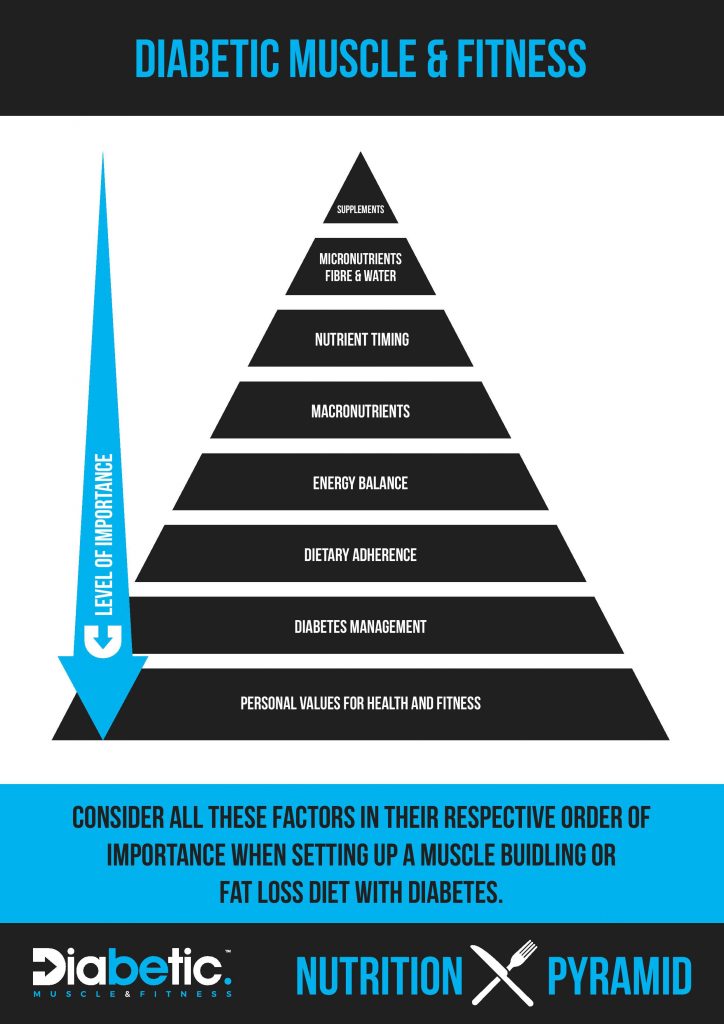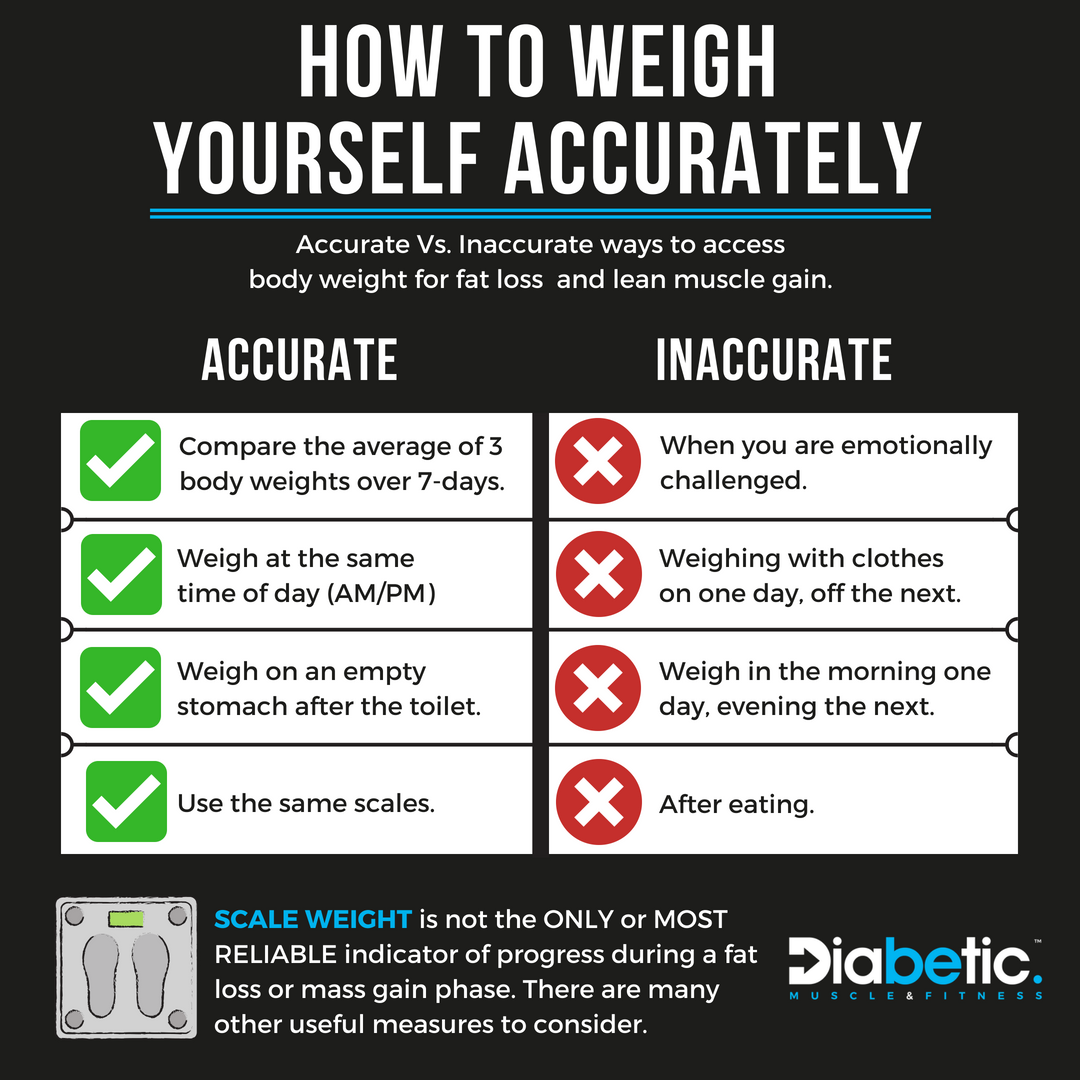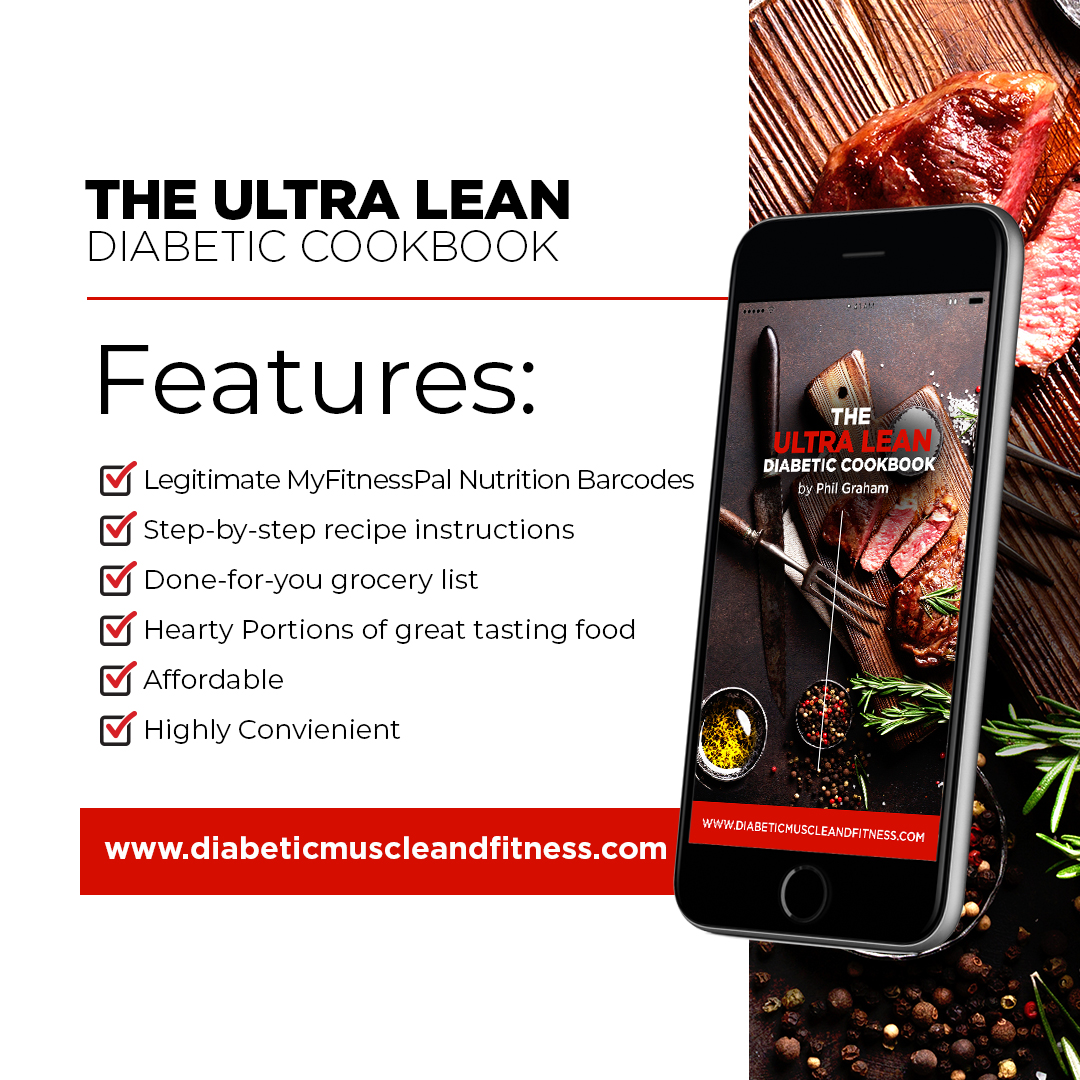Quick Summary
- Women with Diabetes can develop a great looking body, they just need to think differently, and require unique information and support.
- Improving your body is more challenging if you have diabetes. There are many important nutrition considerations.
- The best fat loss and body sculpting diet plan for females with diabetes is the one that fits your lifestyle and isn’t difficult to manage from a diabetes perspective.
- Improving your body involves set periods of eating a calorie surplus and deficit.
- 99% of women looking to lose fat and develop their shape prioritise the wrong things when it comes to diet.
- If you don’t assess your diet you won’t reach your ideal shape.
- You need fewer supplements than you think. Women do well with whey and creatine, and these are valid options for people with diabetes.
What you’re in for?
4,000 Words
Reading Time ~ 22 minutes
Before we begin, let’s get straight with each other why you’re reading this exact article.
You’re a female living with diabetes who wants to look better naked and buy a completely new wardrobe?
You’ve tried to lose weight and get in shape countless times but you still aren’t happy.
No matter how many diets you have tried, you keep asking yourself,
‘What do I need to eat?’
‘How much do I need to eat?’
‘Am I allowed to eat this? Am I allowed to eat that?’
‘What should I do for this night out I have coming up, will my diet fail?’
‘Why am I constantly hungry?’
‘Is diabetes the reason I’m struggling to lose weight and get in shape?’
‘Dieting downright sucks and I have no hope of building a body that men will bow down to.’

Ok, Stop.
Panic over.
If you have struggled to find decent diet information for creating a better-looking body with diabetes, you’ve come to the right place.
This article is grounded on ten years of academic learning, 1000s of blood glucose tests, 1000s of hours in the gym and over 700 client transformations.
You will learn many new things and discover various aspects you haven’t considered before. You’ll walk away equipped with the right knowledge to make massive changes and create the body you always desired.
I’m all for creating a great looking body as fast as possible. However, to achieve this, your diet MUST be set up correctly.
There is a fine line between…
- Eating too much vs. eating too little.
- Taking too much insulin vs. taking too little.
- Training too much vs. training too little.
Overlook one detail and you run the risk of burning out, losing shape, gaining waist inches and looking the same (or worse) from year to year.
Sound familiar?
Let’s look at how we can fix it.
In order to build a great looking body, you’ll need to build muscle and lose body fat.
Nutrition, in conjunction with a well-structured training program and dedicated periods of rest are essential in every woman’s journey to creating the perfect looking body.
This article focuses on the nutritional aspect of developing a great looking body. If you want to learn more about the training, make sure you read this article after.

___
The diabetic body is governed by a different set of rules and requires a much more tactful approach to diet than would be advised by the mainstream fitness media or your local gym hero.
___
Let’s look at the challenges females with diabetes face in their quest to build a better-looking body.
- Increased levels of muscle protein breakdown.
- Reduced strength.
- Decreased joint and muscle mobility due to glycation.
- Increased potential for injury.
- Increased fatigue.
These challenges are real.
However, they only become a serious problem to creating a great body when blood glucose levels are not controlled. You can safely say diabetes is not an advantage, BUT, with the right knowledge, plans and guidance, diabetes DOES NOT have to be a disadvantage.
The more you know about diet, the better you will control your blood glucose levels.
GETTING STARTED:
THE BODY SCULPTING DIET PLAN FOR FEMALES WITH DIABETES.
When it comes to creating your own diabetic fat loss diet plan a number of factors need to be considered. Some are more important than others and must take priority. It’s easy to get excited and place more attention on the small details like the newest supplement, diabetic special food or the best time to consume your whey protein, rather than prioritizing the more important (yet sometimes boring) aspects like the ‘WHY’ behind eating better, overall, calorie intake or diabetes management.
THE DIABETIC MUSCLE AND FITNESS NUTRITION PYRAMID
The Diabetic Muscle and Fitness Nutrition Pyramid (pictured below) outlines all the nutritional aspects of building a successful fat loss diet for females living with diabetes. The most important factors are at the bottom and the least important factors are at the top.
Structure your nutrition like this and you can guarantee high-quality results.

This is the exact hierarchy of importance I have incorporated into my 112-Day Female Focused Fat Loss Transformation Guide for Females.
1. PERSONAL VALUES FOR HEALTH AND FITNESS.

Your personal values for health and fitness are your WHY behind your HOW TO.
Find as many reasons as you can to support why improving your diet will enhance the quality of your life. These answers are the driving force behind your daily attitude and actions.
Confidence, better sex, tastier fashion, job opportunity, and improved quality of life are all obvious benefits of losing fat.
2. DIABETES MANAGEMENT.
Even if a diet is comprised of the best quality and freshest food or most expensive supplements on the planet, poorly controlled diabetes can predispose individuals to malnutrition, a condition where the cells of the body cannot utilise fuel properly.
Malnutrition resulting from poorly uncontrolled diabetes adversely affects body function, well-being, predisposes individuals to disease and delays recovery from illness.
Your diabetes must be exceptionally well controlled in order to reap the full benefits of healthy eating.

3. ADHERENCE.
Whether your goal is to shred pounds of body fat, create a perfect body shape or maintain body weight, your diet plan must be able to accommodate social occasions, days off, and the odd slice of pizza when you fancy it. Yes, a diabetic just said pizza.
The best body sculpting diet plans for females with diabetes incorporate a little give and take. If set up correctly, the total number of calories you consume will allow you to achieve your goal without restricting the foods you love.
Eating ‘clean’ doesn’t mean you’re doing things optimally. This is especially true if you find yourself craving the foods and macronutrients you restricted.
What good is a diet that drives you crazy?
You’ll struggle to get results, never mind maintain them.
Besides being ultra consistent with your calorie intake and essential nutrient targets, the secret to developing a better-looking body is eating a diet you enjoy. Adherence is everything. This viewpoint is also supported by the Journal of the American Medical Association who researched pretty much every fat loss diet on the planet and found ‘adherence’ was the most significant factor behind a diet’s success 9.
How many massively restrictive diets have you started, only to stop once your burst of enthusiasm has been replaced by pure monotony? Time to re-think things?
As for training. It’s only the fun part.
I take dietary adherence seriously. I’ve even incorporated detailed instructions and principles on how you can eat the foods you love, and still get in amazing shape in my breakthrough fat loss diet and training guide for females living with diabetes.
Forget overly restrictive, dull, boring chicken, broccoli and rice diets, carb cycling, detoxes and super expensive supplements.
Focus on sustainability and killer consistency.
Once you’ve identified the goal of fat loss you will need set yourself a time frame, measure your progress and get accountable.

1. SET A TIME FRAME
You need to set yourself an adequate time frame for getting in shape.
How long will depend on how much progress you want to make.
There is a huge difference between,
- Losing 10lbs of fat vs. 100lbs
While developing a great looking physique takes years, generally speaking, 16 weeks is enough time to make significant body transformation changes. This is the exact length of Diabetic Shred – the breakthrough fat loss diet and training plan for women with diabetes.
2. MEASURE YOUR PROGRESS
If you aren’t assessing you’re just guessing.
To get the most out of your body sculpting diet plan, you must learn to evaluate and measure your food intake.
“Tracking food may seem like a mundane task”
Think again, tracking allows you to build portion control habits, and eat more flexibly in relation to your body transformation goals.
Fat loss requires eating less than you burn off. Overeating will hinder your fat loss efforts, while under eating will increase your chances of muscle loss and fatigue.
Far too often people blindly drop their calories and increase their training when there is no need. You must adjust when the time is right. How will you know? Tracking of course!
Having worked with 100s of females in the pursuit of getting a great looking body, I know too well how confusing it can be when it comes to making decisions about when to cut calories and where from. I paid great attention to this dilemma when developing Diabetic Shred.
The plateau is usually the time when people give up on their goals. Diabetic Shred outlines a crystal clear decision process for when and where to adjust your calories, once you hit a plateau.
Having a clear set of questions and actions like this saves hassle, gets better results, and most importantly keeps you progressing not quitting!
3. GET ACCOUNTABLE
To get the most out of your body sculpting diet plan, you must get accountable.
Hiring a coach or personal trainer with a proven track record who understands diabetes management will be worth its weight in gold, especially if it is your first time getting serious.
A good coach will give you that much-needed push during training, along with good honest critical feedback on your development and shape.
Now let’s get into the nitty gritty of nutrition and talk calories, carbs, protein, dietary fat and supplements.
4. Energy Balance
The first place to start when building your diet plan is calories.
Calories play a crucial role in everyone’s attempts to get a great looking body1.
If your goal is to lose body fat or develop your shape, you must first establish how many calories you need to maintain your current bodyweight, and then work from there.
How do I work out my maintenance calories?
Record your body weight and calorie consumption over 14 days. Total the values up and divide each of them by 14 to get your fortnightly calorie and body weight average. Compare this value to your starting body weight…
- If your body weight has gone up, this indicates a calorie surplus.
- If your body weight has gone down, this indicates a calorie deficit.
- If your body weight has remained the same, this indicates maintenance calories.
Oh, and if the idea of weighing yourself seems daunting, here are some useful tips on how to weigh yourself properly.

Another way to calculate maintenance calories is by using a calorie calculation.
These aren’t 100% bulletproof, but they do get you on the right path.
Once you’ve established a maintenance level of calories, you’ll need to adjust it to your goal.
Generally speaking, for fat Loss – eat slightly fewer calories than you need to maintain your body weight.
5. MACRONUTRIENTS.
Everyone gets confused about macros. It’s no surprise considering the vast amount of conflicting and over-complicated information found online and in the papers.
Low carb,
High carb,
High fat,
Low fat.
Which macro split is best for diabetes?
Here’s what you need to know about macros…
Certain macro nutrients are essential, others not.

Protein and the essential fatty acids (Omega-3 and Omega-6) need to be consumed via the diet.
Carbohydrates and other forms of fat are non-essential as the body can produce them by itself.
The best diet contains all the macronutrients in the right amounts specific to your overall calorie goal for fat loss, shape development or body weight maintenance.
What ratio of macronutrients you decide to eat is largely down to personal preference once you have met your essential needs for protein, essential fatty acids and carbohydrates for hypo treatment/prevention purposes.
How much protein do I need?
To keep it simple, 1.4-2.0g per Kg (0.6-1.0g per lb) of protein for the majority of people reading this.
In other words, if you weigh 67kg (147lb) you would consume 90-150g of protein per day. Split equally over 3-5 servings of 20-40g each day.
How much fat do I need?
Generally speaking, consuming 20-30% of your calories from fat is a great place to start. You might consume different amounts each day. However, over a period of weeks/months – they should average out.
In respect to your overall fat intake, certain types of dietary fat are essential, others not.
Omega-3s are essential long-chain polyunsaturated fatty acids that need to be supplied through the diet
There are three types of omega-3s involved in human physiology: ALA, EPA & DHA. Predominantly of marine origin, EPA and DHA are better than ALA found in plant oils, due to their greater bioavailability 2,3.
Consuming fatty fish and fish oil supplements has been shown to improve dozens of aspects of health and disease, including insulin sensitivity, blood lipids, depression, inflammation and blood pressure, to name a few 2,3,4,5,6.
Taking the different government and health organisations’ recommendations into account, 1-3 g of combined EPA-DHA per day suffices. The upper dose of 3g would be more suitable for people with diabetes due to the predisposition of a high triglyceride level and elevated blood pressure.
1 gram of fish oil is the equivalent to around 3 fish oil capsules per day or three to four 112g portions per week of oily fish like salmon, mackerel or sardines.
You’ll want to check how much Omega 3 you can take with your health care professional if you’re taking blood thinning medication.
How many carbs do I need?
Carbohydrate should make up the remainder of your calorie intake once you have calculated your calorie intake for protein and fat. The more carbs you eat, the less fat you’ll eat, and vice versa. The more dietary fat you eat, the fewer carbs you’ll consume.
Think of carbohydrate as a performance fuel, not a recovery fuel. The more training you do, the more you’ll need.
Do I need to go low carb if I live with diabetes?
Not necessarily.
If you are highly active and strength train 3-6 times per week, carbohydrates will help fuel your exercise performance and provide your body with a better training stimulus.
The fibre aspect of carbohydrates has also been shown to play a key role in the health of our microbiome, which has now been repeatedly shown to play a key role in body weight management 7,8.
Carbs provide a range of different vitamins and minerals. They also taste great and help with dietary adherence.
Provided you manage your blood glucose levels and account for the calories you consume from carbohydrate, there is no reason to exclude them. On a side note, you must account for the carbohydrate calories you use to treat hypoglycaemia. This may vary from day to day.
If you”re like most women with diabetes, trying to figure all this out can get pretty overwhelming. One of the easiest ways to overcome this is to follow simple recipe plans. That’s why I created the Ultra Lean Diabetic Cookbook – it’s jam packed with 100 delicious diabetic friendly recipes. All the calories and macronutrients are outlined for you – they even come with a Myfitness pal barcode for easy food tracking.
6. NUTRIENT TIMING
Nutrient timing is more important for people with diabetes, especially when it comes to preventing/treating hypoglycaemia or preventing hyperglycaemia.
Refer to the infographic below and review when nutrient timing is Very Important, Worth Considering and Not Important. It’s the perfect size for Instagram, so please do feel free to share on social media (remember to tag us)

Getting your nutrition timed right has favourable effects on body composition, mood, and diabetes management. However, it should never be prioritised over the more important levels of the pyramid such as energy balance and macro nutrients.
A prime example of this would be the ‘no carbs after 6 dogma.’
In terms of meal frequency, 2-4 meals for fat loss and 3-5 if developing shape.
7. MICRONUTRIENTS/FIBER/WATER.

The topic of micro-nutrition may sound mind-numbing but you can’t overlook it.
Long-term micronutrient deficiencies will have a detrimental impact on your health and ability to perform/recover optimally from your training efforts.
Micronutrient deficiencies can result from prolonged period of low-calorie dieting and poorly controlled diabetes. A varied diet is a great way to get a range of micronutrients in
If you have any problems with energy levels, hunger, skin, or problems sleeping, you might be short of a few vitamins or minerals. Rather than assuming, the best way to check for micronutrient deficiencies is by getting a blood test done.
Fiber Intake
First of all, it is worth noting fiber is not an essential nutrient.
- It makes you feel fuller (helps with fat loss)
- Slows gastric emptying and nutrient absorption (can help with blood glucose management)
- Decreases blood cholesterol
- Decreases mineral absorption
- Provides food for the bacteria in our guts which are shown to play a massive role in health and obesity prevention.
- Helps you go to the toilet.
High-fiber foods like fruits and vegetables contain lots of other nutrients (vitamins and minerals) that are important to health.
If your fiber intake is low, don’t start ploughing it down. The body, particularly the bacteria within your gut need a little time to adapt. Otherwise, you’ll be pretty bloated and be blowing a lot of gas.
Provided you don’t suffer from IBS or any other serious bowel condition, 30-40g of fiber is a great target to shoot for daily.
Water Intake
Water is important for all things health, muscle building and exercise performance. There isn’t really a fixed water goal you should work to, per say, as hydration needs vary widely with body weight, sweat rates and frequency of hyperglycaemia.
Generally speaking,
- Aim for at least 5 clear urinations a day.
- Make sure you’re not dehydrated before training.
- Hydrate yourself well both during and after hyperglycaemia.
- Your hydration needs will increase if you are using the likes of creatine.
8. SUPPLEMENTS.
When it comes to supplements, let’s get five things straight.
- Supplements are the least important part of the nutrition pyramid.
- Supplements can be a great nutritional insurance to someone living with diabetes. However, they will not mop up the damage caused by poorly controlled diabetes.
- Supplements are a healthy addition to a good diet plan, but they will not make up for a poor one.
- Generally speaking, supplements are not needed. Unless you don’t eat oily fish or natural sources of omega 3.
- Supplements are never to be seen as shortcuts.

What supplements do I need?
Generally speaking, protein powder is a convenient easily digested source of high-quality protein, creatine along with caffeine are useful for boosting strength and cognition, Vitamin D is good for health if you live in a dull climate, fish oil seems to improve many elements of health – which makes all of these a worthwhile investment.
Since I consider the subject of supplements such a non-important topic, I’ll cover them in greater detail in a separate article, as I don’t want them distracting from the more important parts of this article.
In fact, I guarantee some people will have skipped everything I’ve said up until now. If you have – go back and start afresh.
If you’ve read the whole way up until here. Great!
Respect the hierarchy of importance for each element outlined in the Diabetic Muscle and Fitness nutrition pyramid, get focused on creating healthy habits over the long term, assessing your progress and just eat real food.

TAKE HOME
Before you pay for another month of gym membership ladies please consider these key principles for losing fat with diabetes.
- Proper female fat loss nutrition is about understanding how to eat healthily and sustainably towards your goals. All diet plans work (for a while), use them as a template from which you can adjust according to your results and personal circumstances.
- Never hop from diet to diet. It’s best to measure progress after about 2 to 4 weeks and then continually adjust.
- The ultimate nutritional approach to sculpt a great body will always be calorie controlled and nutrient dense, along with a diet that supports exercise performance and recovery.
- To get the best possible results your diabetes must be extremely well-managed through regular blood glucose testing and appropriate amounts of medication. This is essential for the proper absorption and metabolism of nutrients from food.
Since you have made it to the end of this blog, you are obviously serious about losing fat and building a new wardrobe (ha).
I hope you take action on what you’ve learnt!
If the idea of building your own diet and training seems too daunting for you,
here’s an 85% off coupon for what many diabetic women have coined the world’s Best Female Diabetic Body Transformation Diet and Training Plan.
Everything is done for you!
Join over 3500+ women who are currently following the plan and creating a better body and life for themselves.
The best thing about it?
It only costs a fraction of a typical 1-hour personal training session. You get 112 days’ worth of first class diet and training content that isn’t available anywhere else in the world, bar here!
IF YOUR GOAL IS FAT LOSS GET DIABETIC SHRED
REFERENCES
- The poor, misunderstood calorie: calories proper: Volume 1 Lagakos Ph.D., Dr. William
- https://www.ncbi.nlm.nih.gov/pubmed/28289069
- https://www.ncbi.nlm.nih.gov/pubmed/23794360
- https://www.ncbi.nlm.nih.gov/pubmed/25278765
- https://www.ncbi.nlm.nih.gov/pmc/articles/PMC4013121/
- https://www.ncbi.nlm.nih.gov/pubmed/24117792
- Le Chatelier, T. Nielsen, J. Qin, E. Prifti, F. Hildebrand, G. Falony, et al. Richness of human gut microbiome correlates with metabolic markers Nature, 500 (2013), pp. 541-546.
- -P. Furet, L.-C. Kong, J. Tap, C. Poitou, A. Basdevant, J.-L. Bouillot, et al. Differential adaptation of human gut microbiota to bariatric surgery-induced weight loss: links with
- Pagoto, Sherry L, Appelhans, Bradley M. A. Call for an End to the Diet Debates




